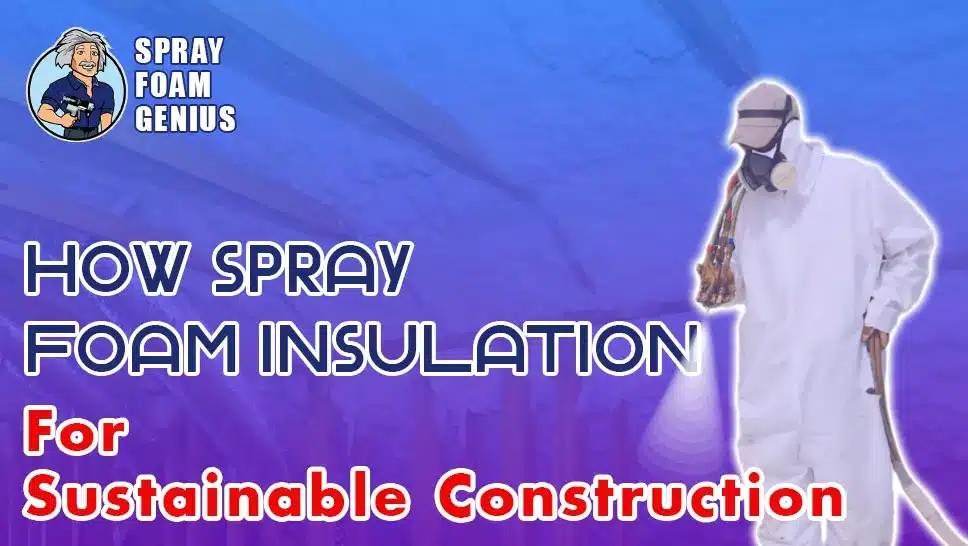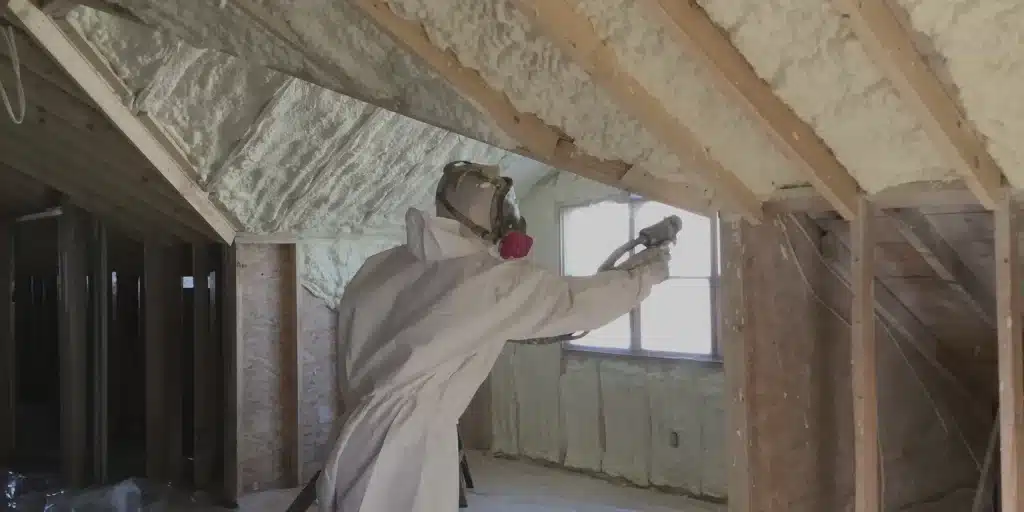
Sustainable construction has become a cornerstone of modern building practices, aiming to minimize environmental impact, enhance energy efficiency, and improve the overall health and comfort of building occupants. Spray foam insulation plays a crucial role in this evolving landscape, offering numerous benefits that align with sustainable construction goals. For spray foam insulation contractors in the USA and Canada, understanding how this innovative material supports sustainable building practices is essential for delivering high-value services and staying ahead in the competitive market. This in-depth guide explores how spray foam insulation contributes to sustainable construction, examining its benefits, applications, and impact.
Introduction: The Role of Spray Foam Insulation in Sustainable Construction
Sustainable construction focuses on creating structures that are energy-efficient, environmentally friendly, and health-conscious. Spray foam insulation is a key player in achieving these objectives due to its superior thermal performance, ability to reduce air leaks, and contribution to overall building durability. This guide provides a comprehensive overview of how spray foam insulation enhances sustainability in construction projects, offering insights into its benefits and applications.
Understanding Spray Foam Insulation
Spray foam insulation is a versatile material that expands on application to fill gaps, cracks, and voids in building structures. It is available in two main types, each with unique properties and applications:
- Open-Cell Foam: Open-cell spray foam is characterized by its lighter weight and flexibility. It has a lower R-value compared to closed-cell foam but offers excellent sound absorption properties. This type of foam is typically used in interior applications where acoustic performance is a priority, such as in residential and commercial spaces requiring noise reduction.
- Closed-Cell Foam: Closed-cell spray foam is denser and provides a higher R-value per inch, making it an excellent choice for applications requiring superior thermal resistance. It also serves as a moisture barrier, making it ideal for exterior applications and areas prone to moisture, such as roofs, basements, and crawl spaces.
Both types of spray foam insulation contribute to sustainable construction by enhancing energy efficiency, improving indoor comfort, and supporting the longevity of building structures.
How Spray Foam Insulation Enhances Energy Efficiency

Superior Thermal Performance
One of the most notable advantages of spray foam insulation is its exceptional thermal performance. Closed-cell spray foam, in particular, offers a high R-value per inch, which translates to superior resistance to heat transfer. By creating a continuous and seamless insulation layer, spray foam helps maintain stable indoor temperatures and reduces the reliance on heating and cooling systems. This improved thermal performance leads to lower energy consumption and reduced utility bills, making it a cost-effective and eco-friendly solution.
Reduced Air Leakage
Air leakage is a significant factor in energy loss within buildings. Spray foam insulation effectively seals gaps, cracks, and joints in the building envelope, preventing the escape of conditioned air and the infiltration of outside air. This airtight seal reduces the workload on heating, ventilation, and air conditioning (HVAC) systems, leading to improved energy efficiency and lower energy costs. By minimizing air leaks, spray foam insulation helps to create a more comfortable and stable indoor environment.
Improved Building Envelope Performance
A well-designed and properly insulated building envelope is crucial for maintaining energy efficiency and indoor comfort. Spray foam insulation enhances the performance of the building envelope by providing a seamless and continuous barrier against air and moisture infiltration. This improved envelope performance helps to regulate indoor temperatures, reduce energy usage, and increase overall building efficiency. By ensuring that the building envelope is properly sealed, spray foam insulation contributes to the long-term sustainability of the structure.
Environmental Benefits of Spray Foam Insulation
Reduced Carbon Footprint
The environmental impact of buildings is closely linked to their energy consumption. Spray foam insulation contributes to a reduced carbon footprint by improving energy efficiency and lowering the amount of energy required for heating and cooling. Buildings with spray foam insulation consume less energy, leading to fewer greenhouse gas emissions from power generation. By reducing the carbon footprint of buildings, spray foam insulation supports broader efforts to combat climate change and promote environmental sustainability.
Longevity and Durability
Spray foam insulation is known for its durability and long lifespan. Unlike traditional insulation materials, spray foam does not settle, degrade, or lose its insulating properties over time. This durability reduces the need for frequent replacements and repairs, leading to less waste and a lower environmental impact. The extended lifespan of spray foam insulation contributes to the overall sustainability of building projects by minimizing the demand for new materials and reducing maintenance requirements.
Reduction in Building Waste
The application of spray foam insulation is highly precise, which minimizes material waste. Spray foam expands upon application, allowing it to fill cavities, gaps, and voids efficiently. This precision reduces the amount of insulation material required and minimizes the waste generated during installation. Additionally, the reduced need for supplementary materials and labor further contributes to waste reduction. By minimizing waste and optimizing material usage, spray foam insulation supports sustainable construction practices.
Enhancing Indoor Air Quality
Moisture Control
Moisture management is a critical aspect of maintaining a healthy indoor environment. Closed-cell spray foam insulation acts as a moisture barrier, preventing water vapor from penetrating walls and ceilings. This moisture control helps to prevent mold growth and maintain a dry and healthy indoor environment. By keeping the building envelope dry, spray foam insulation contributes to improved indoor air quality and reduces the risk of mold-related health issues.
Reducing Allergens and Pollutants
Indoor air quality is influenced by various factors, including the presence of allergens and pollutants. Spray foam insulation helps to seal gaps and cracks that can allow outdoor allergens and pollutants to enter the building. This contributes to a cleaner and healthier indoor environment, which is particularly beneficial for individuals with allergies or respiratory conditions. By improving indoor air quality, spray foam insulation supports the overall health and well-being of building occupants.
Spray Foam Insulation in Sustainable Construction Practices
Green Building Certifications
Spray foam insulation can play a significant role in achieving green building certifications such as LEED (Leadership in Energy and Environmental Design) and BREEAM (Building Research Establishment Environmental Assessment Method). These certifications recognize buildings that meet high standards of energy efficiency, environmental impact, and sustainability. By incorporating spray foam insulation, contractors can help their clients achieve these prestigious certifications and demonstrate their commitment to sustainable building practices.
Integration with Renewable Energy Systems
Spray foam insulation complements renewable energy systems such as solar panels and geothermal heating by enhancing a building’s overall energy efficiency. When a building is well-insulated, renewable energy systems can operate more effectively, leading to greater energy savings and reduced reliance on non-renewable energy sources. This synergy between spray foam insulation and renewable energy systems supports a more sustainable and energy-efficient building.
Case Studies of Successful Applications
Several notable projects have demonstrated the effectiveness of spray foam insulation in sustainable construction. For example, the renovation of historic buildings using spray foam has shown how this insulation material can improve energy efficiency while preserving the building’s structural integrity and historical value. Another example includes the construction of high-performance homes that utilize spray foam to achieve low energy consumption and high indoor comfort levels. These case studies highlight the versatility and effectiveness of spray foam insulation in various construction contexts.
Conclusion: Embrace the Benefits of Spray Foam Insulation
Spray foam insulation offers a range of benefits that align with the goals of sustainable construction. From enhancing energy efficiency and reducing environmental impact to improving indoor air quality and building durability, spray foam insulation is a valuable tool for modern construction projects. By understanding and leveraging these benefits, spray foam insulation contractors can provide clients with cutting-edge solutions that promote energy efficiency, reduce waste, and support a healthier environment.
Ready to Elevate Your Insulation Services?
To learn how our specialized SEO, local SEO, and digital marketing services can help you attract more clients and grow your spray foam insulation business, contact Spray Foam Genius Marketing today.
Call us at 877-840-FOAM for USA and 844-741-FOAM for Canada visit our website at sprayfoamgeniusmarketing.com, or email us at [email protected] to get started.
Let us help you leverage the power of spray foam insulation to make a positive impact on sustainable construction.
- Social Media Marketing for Spray Foam Businesses: What Works in 2025? - February 6, 2025
- Best SEO Strategies for Spray Foam Insulation Contractors to Rank #1 on Google - February 6, 2025
- What is Spray Foam Insulation? Benefits and Applications - February 5, 2025

